About the survey
Between November 2014 and January 2016 ESCAP conducted a survey of 10,000 youth in Cambodia, India, Kyrgyzstan, Pakistan, Sri Lanka and Thailand to investigate the most pressing issues youth in Asia face, particularly social inclusion. Using 180 questions the survey covered a wide range of topics, specifically the extent to which youth are included with regard to education, employment and political activity, as well as social capital parameters such as membership in associations and access to the Internet. The following figures highlight some of the key findings from the data.
Monthly income (USD) per year of education, by gender and wealth category, aggregates of focus countries

The figure above illustrates the impact of education on earnings when outcomes are compared across different wealth categories. As expected, the return to education is highest among those in the highest wealth category and in particular so for wealthier women. Furthermore, for both men and women, those in the lowest wealth category, never reach an income of those in the middle and upper wealth category, irrespective of number of years of education . This result is indicative of the difficulty youth born in poverty face and the challenge of breaking free of intergenerational poverty traps.
NEET rates (%) by age and gender, aggregates of focus countries
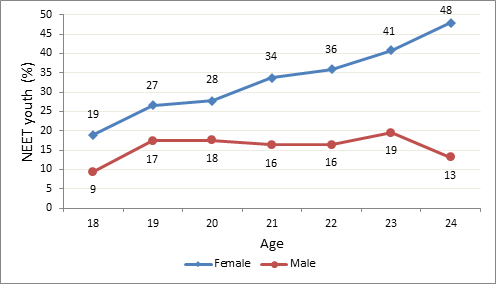
Based on the Survey findings, the majority of respondents spent approximately 11 years in school. This implies that, on average, participants left education at the age of 18. Since the majority of the respondents were no longer in school at age 19, and thus began looking for work, the significant increase in NEET from age 18 to 19 for both genders signals a bottleneck in the school-to-work transition, with many youth unable to find a job immediately following the end of their education. The figure shows how the gender gap in NEET rates starts with a female rate that is twice as high as males at age 18 and significantly widens after age 20. These data illustrate how female youth not only began at a disadvantage but continued to face increasing barriers to employment and education with age.
Internet use (%) by wealth category, focus countries
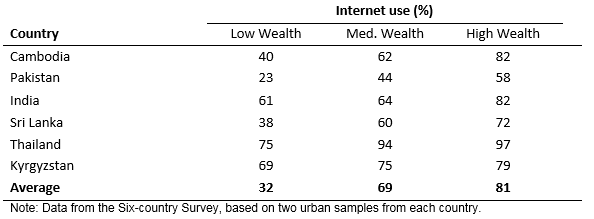
As seen in the figure, wealth plays a significant role in deciding young people’s Internet access. The largest differences, with the exception of India, are between those in the low and medium wealth categories. Moreover, those of high wealth use the Internet over two and a half times more compared to those in the lowest wealth group. Unreliable Internet connectivity resulting from insufficient infrastructure leads to poor Internet experiences if not entire exclusion from using it. As a result, the poor lose out the most. Limited Internet coverage means less access to information, as well as fewer social networks, which, in turn, has a negative impact on young people’s access information about, for example, employment opportunities.
Activity thought to make the world a better place (%) by gender, focus countries
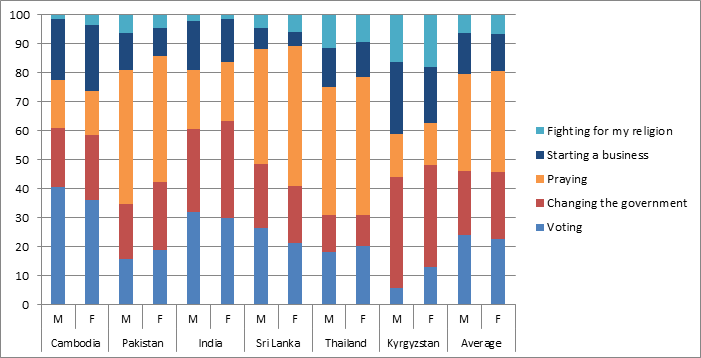
Another question the Survey asked respondents was which activity they thought would make the world a better place by choosing between religious and secular options. The results were highly heterogeneous across countries and at times between genders (displayed in the figure above). The activity with the overall highest percentage is “praying”, with over one-third responding this way. In Pakistan, Sri Lanka and Thailand, close to half of all the youth also indicate “praying.” This outcome is a reminder of the importance to include diverse stakeholders when addressing youth issues, including faith communities and their leaders. At the same time, respondents in several countries indicate that they feel politics is relevant, with voting and changing the government having the second highest percentages, emphasizing the need to ensure youth can participate civically.
Main reason for moving to the city, by focus country

The largest share, nearly half of the respondents, moved to the new city to study whereas only four per cent did so for starting a business, indicating limited opportunities for entrepreneurs (as seen above). A major challenge to increasing the amount of entrepreneurship opportunities is youth’s lack of access to credit. Findings from ILO research in Cambodia show that many of the youth who actually took the self-employment route did so involuntarily, either out of necessity to help their family (19 per cent) or because they are unable to find a wage or salaried work. The most significant business challenges faced by the young self-employed are insufficient financial resources and insufficient business expertise.
Primary reasons for migrating (%) by wealth category
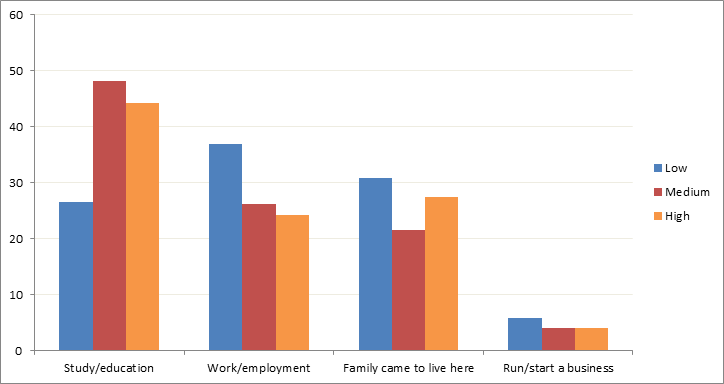
The level of wealth of a young person can also influence the motive for migration, as seen in the Figure above, with close to half of the migrants from the medium and high wealth backgrounds migrating for education, again suggesting that education becomes a higher priority as wealth increases. Reflective of this, migrants from the high wealth category had on average three more years of education than did migrants from the low wealth category.
Youth stating other people thought their religion was dangerous or radical (%), focus countries
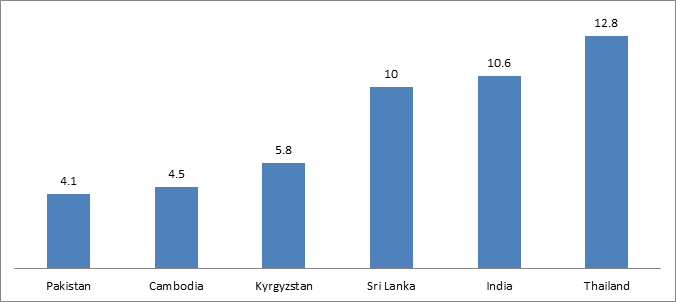
Given the importance religion plays for many young people, the Survey asked a wide breadth of related questions, including how one thought others viewed their religion (as seen in the figure). In India, Sri Lanka and Thailand, some 10 to 13 per cent of the respondents feel that other people view their religion as radical. This perceived feeling is indicative of the mistrust between different religious groups. In Thailand’s case it reflects the tensions between the Buddhist majority and the Muslim minority in the south of the country, which has been a cause of ongoing conflict, also involving issues of language and culture. Reflective of this, only 1.6 per cent of Bangkok respondents felt their religion was viewed as dangerous or radical compared to 24 per cent of respondents in Pattani.
Religion was also discussed in the FGDs, which shed light on the plurality of opinions among youth in the six countries. From these discussions, youth in the south of Thailand indicated their frustration is based on feeling discriminated against. Similarly, in Sri Lanka, youth indicated that the civil war increased tensions down to ethno-religious lines. Circumstances and events such as these add to the breakdown of dialogue between different religious groups and in this case leave people feeling their religion is categorized as dangerous or radical.
Politically active youth (%) by wealth category, focus countries
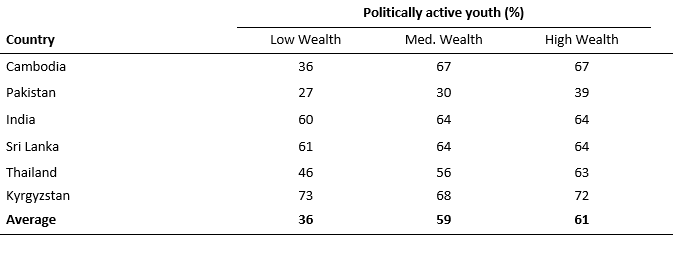
Based on the data in the figure above, wealth appears to have a stronger influence on the degree to which youth are politically active. In particular in Cambodia, Pakistan and Thailand, where far fewer youth from lower wealth groups are active compared to their more affluent peers. A reason why economically disadvantaged youth might be less politically active is linked to their access to media, specifically the Internet. In support of this argument, more than twice the number of respondents from the high wealth group has Internet access compared to the low wealth group. As discussed earlier, the Internet is pivotal to increasing youth’s access to information concerning politics and the exchange of information regarding politics; without this access youth face additional hindrances to being politically active.